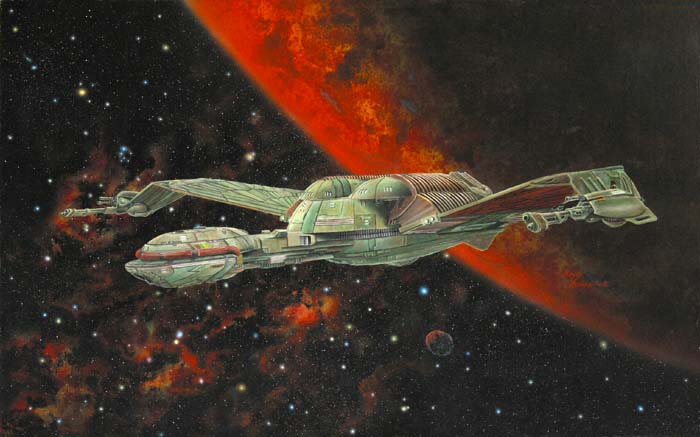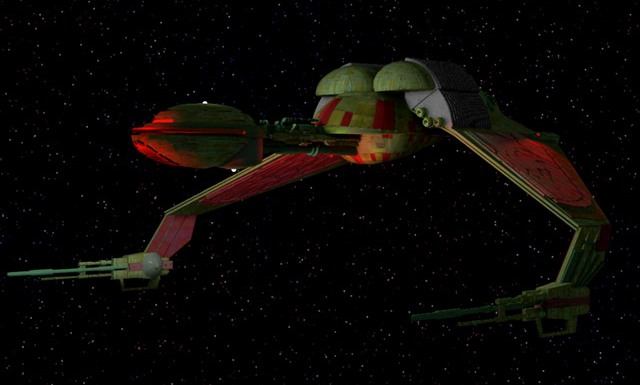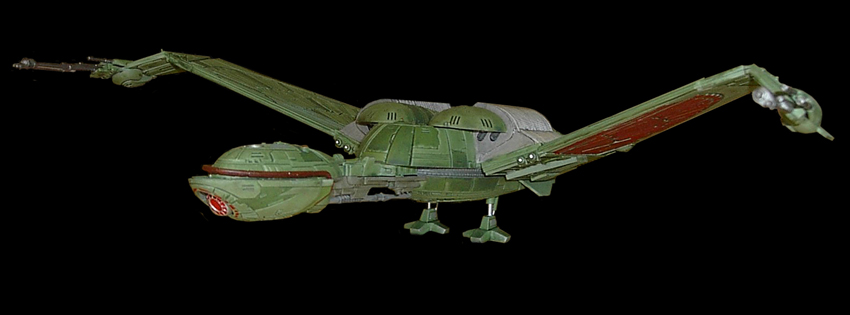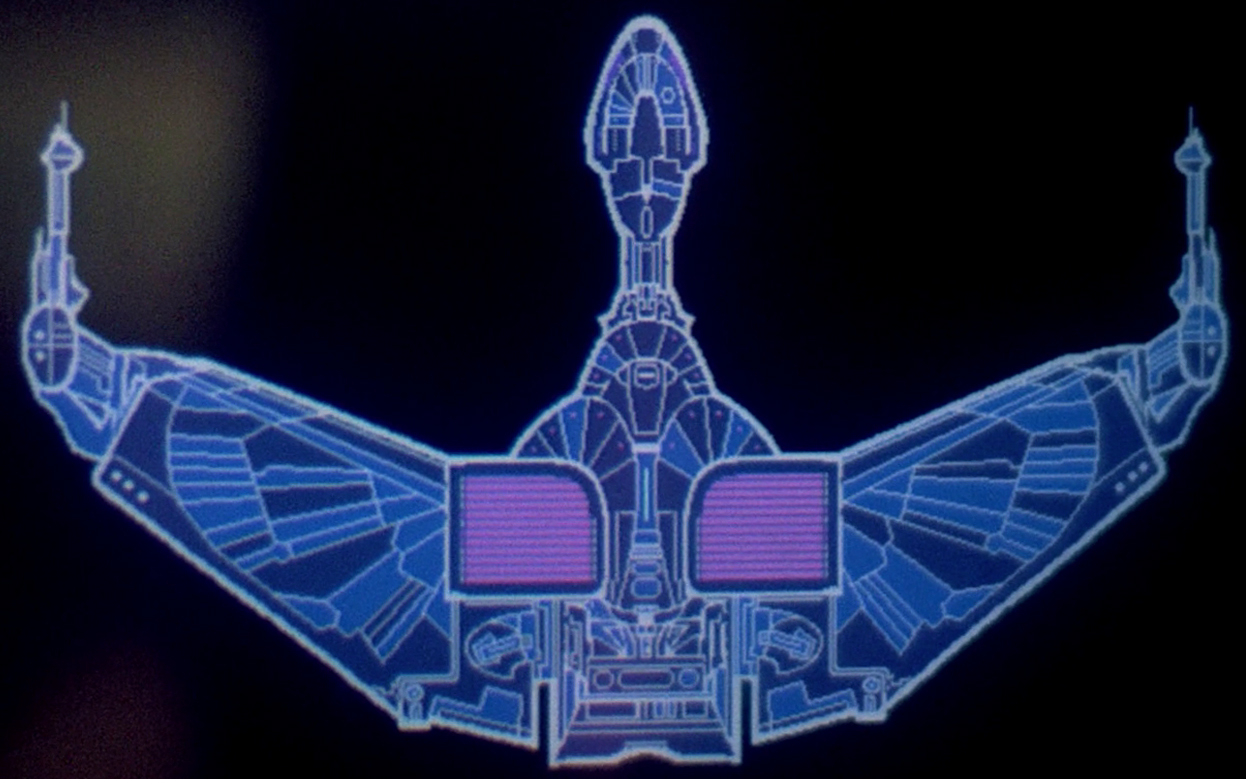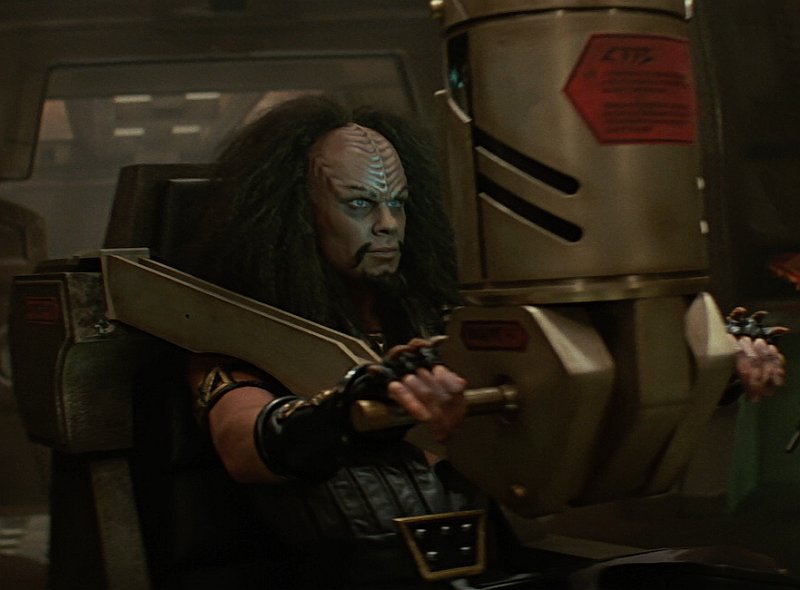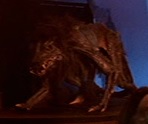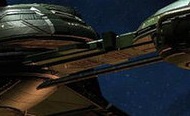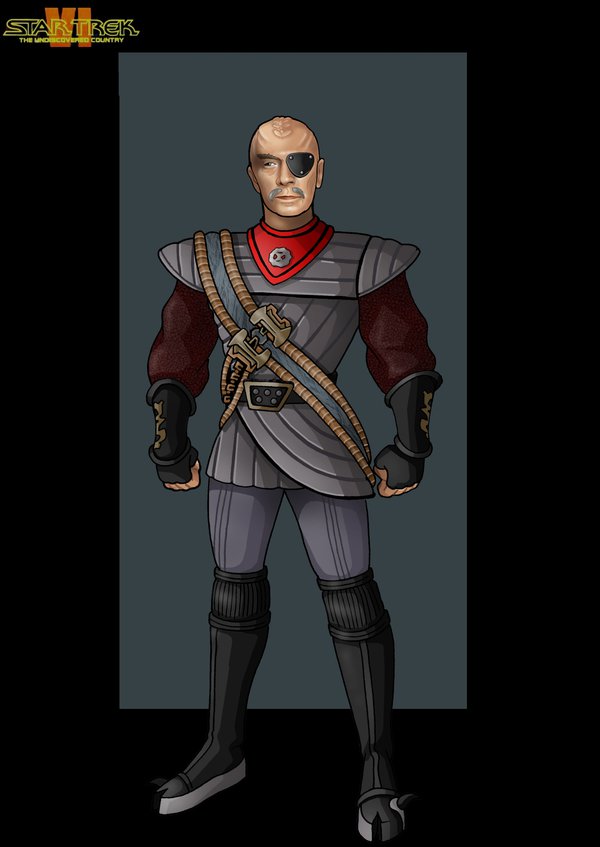 Clingohn Alliance. | Bird Of Prey. |  Clingohn Alliance. | |||||||||||||||||||||||||
|---|---|---|---|---|---|---|---|---|---|---|---|---|---|---|---|---|---|---|---|---|---|---|---|---|---|---|---|
| ACCLAMATOR-Class Assault Ship compares very favorably, but for two characteristics; The ACCLAMATOR-Class was designed as a battle ship and troop transport, and as such has much heavier weapons and a much, MUCH troop capacity (16,000 to the B'REL'S absolute top capacity of 50), but the B'REL possesses a much better maneuvering capacity; In fact, ton for ton it compares favorably to a fighter, with a traverse and advance ration of 4.5 to 1 at flank speed (at lower speeds, they can get down to 10 to 1 or better, though the B'REL suffers the odd deficient that at speed between 1 and 100 mph, they have a 1 to 15 t&e, between all stop and 1 mph of a -1 to 1 t&e, and at all stop of -1/2 to 1, meaning she actually goes backwards slightly during the turn). An ACCLAMATOR has a t&e of at least 1 to 5 (slow bell), and as much as 1 to 100 (flank speed). The B'REL'S handling characteristics have caused them to often, mostly affectionately, be referred to as "gorilla fighters" for their huge size. One of the B'REL'S greatest assets is adaptability; Over the centuries (the B'REL is far and away the longest serving class in the Atran Galaxy after the Beorge CUBE-Class) the ships have been reconfigured to a degree that the original designers probably thought wouldn't BE possible. They have been re-powered (the current design uses a powerplant that would not have been possible 700 years ago), re-armed (not a single original weapons system is installed in any current B'REL, and only three of the first hundred years worth can even BE found, none of them in working order, and all three in museums), re-armored (the original armor isn't even good enough to serve as internal bulkheads, and only intermittently throughout the fleet can you find ships with partitions of the same grade), and every single sensor and avionic system replaced (with the exception of the Captain's Gyroscope and Chronometer, and ancient design kept for traditional reasons, and no longer used as working tools). Even the crew's berthing have been retrofitted; In the original design, crew's berthing consisted of 3 times 5.5 steel shelves (with blankets only if the crewmember brought their own). Now it consists of a 4 by 6 by 1/2 alloy box that doubles as the crewmember's locker, with a 4 inch hard foam mattress with built-in head support and a wool blanket. (Not comfortable, even by Clingohn standards, but that's how they like it.) History The B'REL-Class dates back to the mid-22nd century, when the Clingohn Empire needed many ships very quickly. A scaled-up version of a fighter was developed as a proof-of-concept craft, then developed into the first B'REL-Class ships. These early craft were slightly shorter and slightly thinner than the current versions (about 100 or so years after the first ships came out the neck was lengthened, and about 20 years after that the wings were retrofitted to a longer, thicker, and deeper configuration to accommodate heat sinks for more efficient operation). These wings also introduced the variable geometry concept still in use, as the original wings (which were fixed) would lie against the ground when landed, which would eventually have broken them off. (Records indicate that the Clingohns considered making the wings into the landing struts, thereby opening up more internal space for more equipment, but that the wing designs of that era would not support the weight.) About 200 years after the first ships came out, the new ships coming off the same construction ways began showing a larger and longer hump, as a new powerplant was being installed the required more room. This powerplant has since been replaced with a smaller, more powerful powerplant, but the ship's hull has not been redesigned to account for the new equipment, as the slightly greater internal space that is now void "could" become greater powerplants requiring the greater space later on. (Also, it's at more 100³ feet, making the cost of redesign prohibitive compared to the gains, which amounts to 1/4 ton of total metals.) Despite the age of the B'REL-Class, the ships fought valiantly during the Dominion War and featured in every battle of that conflict (the last major war before the UGC's official arrival); Constant upgrades have ensured that the ships are still a powerful and capable front-line warship. In the hands of a seasoned and aggressive commander, they can engage multiple fighters and expect to come out victorious. They were considerably more agile than V'ROCHA-Class Battlecruisers, making them much better suited for some tasks.
Technical Data Physical Arrangement Design Overview Comparable in design to its 22nd century predecessor, the exterior design of the Bird-of-Prey utilized the same basic avian design, including vaguely feather-like hull plating on its wings. The "feather like" hull plating, while aesthetically pleasing, isn't aesthetic in nature. The separations allow through-hull fitting, including verniers and heat sinks. The bulk of the ship's overall mass is incorporated in the main engineering section of the ship (aft main hull). The bridge module is located on a bulbous forward section, which was separated from the aft section by a relatively thin connective hull that attached to and flared into the aft section, which swept from the main body, forming wings. The wing-design was characterized by its multi-positioning for various flight modes. Located on the caudal section of the ship were ship's stores bay, impulse engine and warp nacelle. The nacelle was positioned diagonally along the aft section of the ship, above the main hold, and perpendicular to the impulse engine. Tactical Systems The current B'REL-Class is equipped with the Klingon Empire's best weapons and finest warriors. They are always prepared to go into battle instantly. The standard ship's weapons of the B'REL-Class included twin forward-firing wing-mounted disruptor cannons, dual photon torpedo launchers (positioned fore and aft) and deflector shields. Waist mounted medium disruptors for ground support and "as much as" 50 infantrymen round out these figures. (The waist mounted disruptors "can" be used in ship-to-ship action, but are generally not powerful nor long ranged enough to be of use in this capacity, and are used as anti-boarding weapons in space- In fact, they're kept in the docking collars, both in space and over a planet.) The ships generally outmatched by any UGC front line ships, especially the Spacy's, but they have proven more than a match for several other contemporary vessels of the Atran galaxy, including the Empire's own VOR'CHA-Class cruiser, which posses roughly twice the firepower (as demonstrated at the outbreak of the Klingon Civil War, when two B'REL were nearly successful in defeating a VOR'CHA in an ambush before a third B'REL came to her rescue). The B'REL also proved to be very successful against the Dominion's Jem'Hadar fighters; On more than one occasion during the Klingon-Cardassian War and Dominion War, B'REL commanders successfully engaged and defeated Jem'Hadar fighters. During one encounter, a B'REL was ambushed by three Jem'Hadar ships, considered to be long odds, and the fact that the ship was able to successfully escape in one piece was good fortune. The most vulnerable spot on the B'REL was located dorsal to the ship's hull, unable to withstand a shot from a system-5 disruptor (capable of breaching the hull within two shots). Additionally, their targeting systems can be easily fooled, both to accept targeting information for objects that are not there, and to ignore or mis-target objects that are; During the UGC-Clingohn War (just after annexation, when some Houses chose not to join the UGC and attempted to break away), the Spacy used this to good effect, 'spoofing' the targeting systems to miss fighters entirely, and to mis-target warships, often to the point where the targeting system said the shot HAD connected when in fact it had gone well-wide, and very often tricking them into believing they'd targeted fighters when in fact they hadn't. (GM's; The issue is the ranging system; The closer an object "appears" to be the easier it is to target. Spoofing the laser based ranging system into believing the target is closer vs. the apparent size makes the system over- or under-shoot.) The B'REL'S neck is surprisingly one of the more resistant sections of the ship, capable of withstanding the change in pressure caused by a hull breach. At least two tractor beam emitters are mounted on a B'REL-Class, specifically on the "head," behind and below the torpedo launcher, and between the wings, below and in aft of the impulse engines. Though not "specifically" weapons, the tractor beams can hold an object relative to the ship. Defensive Systems Cloaking Device B'REL'S are outfitted with a cloaking device, key to the ship's success in battle. The cloak permits the use of communications and sensors, but not weapons systems; The sensors are "fuzzy" while the cloak is raised, and therefore the weapons systems can't get a lock (good or otherwise). Also, the cloak leaves an "energy surge" that can be picked up on close-range sensor scans as a "distortion," tipping off an observant opponent to the vessel's presence. There was approximately two seconds of vulnerability from the time a B'REL'S cloak began is engaged/disengaged and the raising/dropping of the ship's shields; This issue was resolved, and in part the energy surge as well, by the development of a limited shielding array that remains active while the cloak is raised. The cloaking device used on D12-Class were susceptible when exposed to a low-level ionic pulse, which caused the vessel's cloak to engage and its shields to drop. This SERIOUS design flaw was corrected in the B'REL-Class. Shields The B'REL-Class utilizes the same shielding technology as the rest of the Klingon Fleet, but is no less capable; In fact, it's the exact same type used on the much heavier Propulsion Systems Under normal conditions, a B'REL is capable of making at least warp 7. Under ideal circumstances, they can reach warp 9.8 while initiating the slingshot effect; Much of this speed is due to gravitational pull and not the vessel's intrinsic capabilities. The primary impulse injector is located on Deck 5. As a damage control option, a containment problem in the warp core can be compensated for by an adjustment to the tritium intermix. Environmental Systems The B'REL-Class has relatively crude environmental support systems, but they are robust; They can in fact continue to clear air and water, even if the ship's power is gone, via local hand-cranked machinery. (In fact, the air and water filtration systems came from an ancient model, predating the Klingon's first forays into space; motorization was added to make it "easier" to use, the addition of hand-cranks was not an afterthought.) There is a constant 'haze' of smoke from the various systems running, generating heat and smoke, and the water is NEVER cold (at least not off the taps), but it clean enough to use. Berthing As already discussed, the crew berthing is relatively spartan. A 4 foot by 6 foot by 1/2 foot alloy box that doubles as the crewmember's primary locker (a 1/2 times 1/2 times 3 foot battle gear locker is also provided) is the crewmember's rack- An average male Klingon being 7 feet tall, this is relatively cramped. A 4 inch hard foam mattress with a build in cranial support (like a very hard pillow) provides what little comfort the crewman will receive. Even in the Cabin, or an Admiral or General's Cabin, the racks are not significantly improved; A Captain's Rack does include a much larger secondary locker (either underneath as drawers, or on the inside as a chest using the rack itself as the lid thereof; on some ships, a combination of both is used), and on most ships a fold-out plate suitable for a desk is included. Water-based showers are also used (rather than the sonic-based showers often seen throughout the Atran galaxy for their water-saving "benefits"), and, in a deep rarity in the Klingon fleet, a steam bath is included. The steam bath is open to all members of the crew off watch, without regard to rank; This is one of the few places where crew members of different rank status (Officers vs. Enlisted) may openly speak to one another in ways that would not be permitted to elsewhere (in other words, fraternization). In mixed sex crews, it is quite common to see about half the racks open at any given time, despite the fact that the racks ARE assigned. (This is also quite common on female-dominated ships.) Interior Layout The interior arrangements of a B'REL-Class have varied significantly over time, but universally have limited space available for the very fact that it was designed as "a military ship, not a pleasure craft." Life aboard one has been very generously described as "cramped and uncomfortable," even when compared to the spartan conditions on contemporary warships. In fact, UGC prisoners who have been transported upon B'REL-Class ships have generally referred to prison ship conditions as better; The mattresses are more comfortable, the racks larger, and the food "usually" better. Non-berthing conditions are generally no better. Main plant has the most overall open space, due to a refit to the hull configuration 2 centuries after they first came out to accommodate the larger and more powerful powerplants that were later replaced with smaller and slightly more powerful still powerplants, but that's really about it. The addition of the steam baths reduced crew fatigue significantly, and the gym on Deck 8 gives a place to relieve some tension (rank plays no role in the gym, but certain decorums of rank are enforced, even there- no such enforcement is made in the steam bath). One of the very FEW luxuries found throughout the ship in a deliberately released fog, generated from the sap of a tree often used as a condiment or ingredient in other dishes (very much like jorvish or maple syrup); As a result they have an incongruously sweet smell. This fog is secured during battle, however, and the somewhat noxious "normal" fumes of the ship return. (Most captains include securing the fog during battle stations drills, a daily occurrence for a ship underway circumstances allowing, to give the crew a taste of the "fog of war.") Although not strictly speaking authorized, barbell-shaped neck massagers are often used as "headrests" both at consoles and on racks. Officially the captains of the Klingon Fleet are supposed to have them removed. None do, and most openly flaunt their disregard for this regulation. The most contemptuous captain in this regard was Ra'wI' SHOCHACHE, Of The House Of Yorgh, who personally purchased such devices for each member of her crew out of ship's funds and gave them to her crewmembers to keep upon departure. As she explained later on, it was not for comfort, nor to improve efficiency; She did so as an open act of defiance, nothing else, and bragged about her actions before the Emperor HIMSELF, as if daring him to act. (The Emperor, for his part, laughed and informed her that such actions were not to be encouraged- but that he wished he'd had "those kinds of [stones]" when he himself was a Ra'Wi'. Then he promoted her, in the normal course of Imperial business.) Main Bridge Due to their age and variety of configurations, the main bridge included numerous variations. All bridges incorporated a viewscreen, most of which were elongated octagonal shape, built into the forward bulkhead. Many, especially older ones, have additional viewscreens around the bridge allowing the commander to track other objects as they are relative to the command dais. Over time, the bridge work stations have moved up and down on platforms; Seats have been added, removed, added again, and removed again. The current generation of B'REL use consoles without platforms (allowing the commander to have a clear view of their crew's displays and actions) and with seating (the seating has restraints to prevent the crewmember from being thrown from their station, thus reducing needless injuries). The seats can be swung away and the console itself raised, allowing the crewmember to stand at some points, discouraging sleep (the purpose of removing seats over time). Each station has a drop-down or rise-up scope that can be toggled to any ship's system, though the default in usually to that stations purpose. The commanders of most ships have theirs toggled to ship's weapons, allowing them to target objects themselves. This unique characteristic has been copied onto most Spacy and all Patrol ships, though most UGC captains continue to use their crew's own actions, and rarely take manual control of a weapons system.
Normally three stations are located forward of the Command dais, one the helm/navigation the other two weapons, allowing the captain quick access to those stations. Two more stations are located aft, to either side of the dais. Each of these two stations had a small data port for recording incoming transmissions and a lower monitor that could not only display such transmissions, including playback of data that had been recorded upon reception, but could also detect, track and identify vessels in proximity of the ship. The command chair could swivel to face either of the aft stations and each of its arms bore a thin panel of controls. These stations are divided into engineering and damage control, though the engineering station has only limited control of the ship's machinery, and the damage control station has NO control other than to seal off damaged sections and to close most fuel, power, and other lines. Mostly they are used to monitor their respective functions. An oval access point aft allows access from the bridge and have a pair of curved double-doors that slid open. These doors lead to the rest of the ship and opened directly into the neck passageway. Like the rest of the ship, the bridge is very cramped, difficult to work in and tight, but ultimately very effective. The bridge is kept a bit darker than most of the rest of the ship, since eye sight is effected in the negative by lighting. It also helps keep the crew a bit on edge and aggressive. Both of the control panels in the joint helm/navigation station at the fore of the bridge are rigged to retract when they were not in use into the central instrumented pedestal. There are also two other stations which are not normally manned, and can be set to any function the user wants. The portside station, where the ship's Executive Officer normally stands, is typically defaulted to communications.
Most command dias' also have a "Kruge Link," a simple staple into the deck about 2 inches from the base of the commander's seat. The Kruge Link was named in honor of Wa'DIch 'aj Kruge, Of The House Of LHYOD, who kept a rather large, partially feral jadashha named Warrigul. Wa'DIch 'aj Kruge was not unknown to release Warrigul to "discipline" his crew… Though typically he just killed them using the beast. Those commanders who use the link typically run the leash through the link, then hook the end to their chair, ensuring whatever animal they have there can only get loose when they WANT it to. A pair of circular hatches on either side of the bridge provide a means of evacuation in emergency circumstances, accessed by a short ladder underneath. These can not be used in space, however, without the crew wearing spacesuits, and are typically not used in an atmosphere. Some commanders, however, order them opened anyways when possible, usually to air out the ship. Sickbay The sickbay of a B'REL-Class is extremely small and cramped, dully illuminated and featuring a dark gurney beside a bulkhead that includes a red-lit screen. Fortunately, the sickbay connects directly to the messdeck, where wounded are typically brought for treatment. Not that the sickbay on the VOR'CHA-Class is really any better; Klingon medicine is, even now, rudimentary, on par with or slightly behind T'sentraedi "medicine" as it stood during the time of the Fɪʀsᴛ Rᴏʙᴏᴛᴇᴄʜ Wᴀʀ, though under UGC guidance it is "improving" (mostly by force). Ship's Hold The B'REL-Class have a bay that approximately sixty feet in length. This space features a long isle between two wider storage areas, one situated on each side of the ship. A short horizontal barrier separated the walkway from the storage areas and many structural supports extended vertically from this barrier, placed between the barrier and the room's overhead. The space's forward bulkhead includes an open doorway on the port side, leading into a recessed passageway on the starboard side. The doorway opens straight ahead into the vessel's engine room while the passageway is angled straight starboard, leading to a small bay nearby.An automated set of large double-doors that allow exit and, if the door is powerless, an explosive can force it open. At least one of the bulkheads in the cargo bay, located adjacent to the opening of the recessed corridor, can be opened to allow large-scale passage into the ship from above its hull; This door encompasses the whole of the hull in that area, making it "seem" to be hull. Even most observant people do not notice this at first, since it's the complete hull, with framature and everything. Engineering The engine room is located fore of the hold and includes an open doorway that enabled passage between these two adjacent areas. Another door, on the opposite side of the engine room from the open doorway, leads towards the bridge. A third door is built into a bulkhead that is between the two other access points, next to a small trapezoidal slot in the bulkhead through which the dilithium chamber can be accessed. The engineroom has the equipment to control the ship, but not very well, and is only used in this capacity to return home. Messdeck The messdeck includes adequate seating for about nine crewmembers at a time, at two long, zigzagging tables that were positioned parallel to each other. The seating arrangement in this relatively open space was such that some of the crew would be facing at different angles from each other, while others sat facing the same direction as one another.Like most of the other areas aboard the ship, the messdeck is dully illuminated with red-tinged light. It has only one door, which was located on the opposite side of the room from the lighting grilles. The compartment's overhead is lined with rows of small, circular, white lights. Captain's Cabin The Captain's Cabin serves berthing, mess, head, office, ready room, and auxiliary bridge (though limited); The captain "could" run the entire ship from here, though he couldn't operate the guns and the ship would be moving sluggishly. It's mostly to either regain control in the event of mutiny (not that uncommon before the UGC's arrival, and still far too common for the REF to like), or to get home in the case of a catastrophic casualty. Uniquely throughout the UGC and her subordinate states, the Klingons continue to keep the captain TOTALLY separate during meals; Space limitations being what they are, the captains of the B'REL-Class eat in their cabin, rather than with the other officers, as is the norm in other fleets.
Neck Passageway A passageway located in the "neck" area of the B'REL-Class serves as possibly their most iconic feature, which combined with the wings imparts a "bird" appearance, hence the name. This passageway allows access between the ship's bridge and the rest of the ship. The passageway has a metal pipe running horizontally along the length of the port bulkhead that contains most of the control and power cables and at least two sets of double-doors, one between the passageway and bridge and the other between the aft hull and the passageway. Along the passageway are a few small spaces, most being used for sensory stations damage control and repair equipment. The spaces between the frames along the neck are far too small to accommodate full compartments, but failing to use them would have been wasteful. Because of the damage containment measures built into the neck, the forward and aft hulls can be operated as separate elements if the neck is broken, essentially turning the head into a lifeboat, though not a very good one; The crew in that section will typically die in only a few weeks, if that long. Computer Core A compartment of the B'REL-Class contains the computer banks. Interlinked monitors lined each of two opposite sides of the compartment while, in a corner between these two bulkheads, smaller readouts were displayed on a panel, whose two main surfaces formed a reflex angle. An access point is situated on the fourth side of the compartment. The monitors are built into pronounced sections of the bulkheads and slanted downwards, towards the viewer. The readouts on the panel are on level surfaces but the top of both sides of the panel are also slanted. A long console positioned near the center of the space and a panel of white light are found to the side of the door. These lights are fixed batlans, and as such have built in batteries in the event of loss of power. Escape Pods The B'REL-Class include eight escape pods, four along each side. However, this isn't near enough for the entire complement, despite each one being built to hold 5 each, unless the ship is undermanned.
These ships were noteworthy for some characteristic; However, most were used by criminals or terrorists. In 2293 a B'REL existed which had the unique ability to fire torpedoes (but not disrupters) when the cloaking device was engaged. Normally this would not have been possible, since the ship can't see clearly enough to train her weapons in cloak, and the power used to maintain cloak made it impossible as well. This vessel was commanded by the rogue General CHANG to assassinate Chancellor GORKON of the Klingon Empire while implicating the Federate of the crime. The ship was destroyed at the first Khitomer Conference by two Federate ships using modified proton torpedoes (using gas sensors in place of normal tracking/targeting systems) to find the ship, then blasting her with enough firepower to destroy a spacestation by two ships; Once the first torpedo struck, the ships simply poured everything they had into the relatively minor explosion. The defect that exposed her, the cloak's inability to mask "neutron radiation" (high-energy plasma discharge, such as the exhaust from the ship's impulse engines), can not be resolved, since the ship would completely fill with such gasses in minutes if any attempt were made to contain them. The DURAS sisters, Lursa and B'Etor, modified their ship for smuggling. With this, they built a minor financial empire for several years; They even smuggled Remulous Empire operatives into the Federate who would eventually play a pivotal role in the destruction of that empire. The ship itself was destroyed, and her son was unable to aquire her. Model Type: Warship. Class: Heavy Corvette or Light Frigate. Crew: 6 skeleton, 35 max. Troops: 50 infantry max. Vehicles: None. M.D.C. By Location: | |||||||||||||||||||||||||||
| Hull: Mega-Disruptors: Siege Disruptor Cannons (6 banks of 2 each): Photon Torpedo Launchers (2): Warp Nacelles (2): | 90,000* 2,000 each 800 each bank 1,200 30,000 each | Impulse Engines: Bridge Support Structure Primary Bridge: Auxiliary/Flag Bridge: Variable Force Field: | 15,000 20,000** 30,000** 30,000** 8,000 per side (48,000 total)*** | ||||||||||||||||||||||||
| Notes: * Depleting the MDC of the hull will put the Bird of Prey out of commission. All internal systems will shut down, including life support and internal gravity. The ship itself will be an unsalvageable floating wreck. ** The ship have an auxiliary bridge; Even if both are destroyed, the ship can still be piloted from engineering but ship is -3 to dodge and all weapon systems will be at local control. Weapon hits near the bridges that do not penetrate the ships integrity can injure crew members on or near the bridge. Destruction of the support structure of the bridge will remove the bridge section from the rest of the ship. The auxiliary bridge is buried in the main section of the ship and is not effected. *** Shields positions can be varied and all could be combined in one shield. Shields regenerate at the rate of 5% (2,400 MDC) per melee round. Speed and Statistical Data: Driving on the Ground: Not Possible. | Sublight: Has a special sublight engine that allows the ship to travel up to 60 percent of the speed of light. Star Ship can accelerate/decelerate at the rate of 0.8 percent of light per melee round. As an alternative, the starship can reach .99 of the speed of light but is normally restricted to slower speeds so that starship is not effected severely by time attenuation that occurs at the higher sublight speeds. Atmospheric Propulsion: Maximum speed is Mach 8 using impulse engine. The starship have gravitic propulsion systems and can land. Stardrive: Uses a warp engine that allow ship to travel at Warp Factor 5 on cruise (0.024 light years per hour), Warp Factor 8 Flank (0.11 Light Years per hour), and Warp Factor 9.6 Emergency (0.22 Light Years per Hour). Speed is calculate using a formula designed to emulate Star Trek: Next Generation speeds. These speeds are very slow when compared to Phase World ship, so if used in that universe, they could be increased enough to operate within Three Galaxy speeds but should not exceed them. Maximum Range: Effectively Unlimited by either Drive system. Ship carries about one year worth of supplies on board. | Length: 2,225.6 feet (678.36 meters) Height: 1,390.15 feet (423.72 meters) Width: 2,561.1 feet (780.62 meters) Mass: 1,890,000 metric tons (Deep Space Nine: Technical Manual) Power System: Anti Matter with 5 year life span. Ship normally only goes 2 years between the ship being refueling. Cargo: Cargo holds are scattered about the ship that allows for carrying up to 20000 tons of Cargo in addition to standard compliment of supplies and ammunition. Market Cost: 5.5 billion credits to construct. Weapon Systems: | 1. Mega Disruptor Mounts (2): These are mounted out on the wings of the ship and are in the same place as the pulse disruptors on the smaller bird of prey are located at. They are upgraded when compared to the phasers used on the K'T'Inga class battlecruiser. Used as anti-capital ship weapons and can take out frigates in one shot or do large amounts of damage to bases or larger ships and have a far longer range than the pulse disruptors. The Disruptor cannons can be combined or used separately. They cannot be used faster than the speed of light. Weapon has standard penalties to hit fighters and small targets. The barrels can be fired forward only but can be rotated 30 degrees horizontally or vertically. | Maximum Effective Range: 93,300 miles (150,000 km) in space and 93.3 miles (150 km) in an atmosphere. Mega Damage: 2D4 times 1000 MDC each and can be combined for a damage equal to 4D4 times 1000. Rate of Fire: Maximum of Three (3) times per melee per cannon. Payload: Effectively Unlimited. 2. Six (6) banks of 2 Siege Disruptor Cannons: These disruptors are mounted on the hull of the ship. The ship primary beam weaponry not including special weapons that are mounted in the ships weapons pod. Two disruptor banks are located in the front of the ship, one disruptor bank is located on each side, and two disruptor banks are located aft. The weapons damage is about equal to laser cannons used by the CAF but the Disruptors have a greater rate of fire. The disruptors are also slightly shorter ranged but only slightly. Both Disruptor Cannons in each bank can be linked or can be fired separately. They cannot be used faster than the speed of light. Weapons system have half penalties to hit fighters and small targets. Maximum Effective Range: 12,437 miles (20,000 km) in space and 12.4 miles (20 km) in an atmosphere. Mega Damage: 2D6 times 100 each or 4D6 times 100 for both cannons in a bank. Rate of Fire: Maximum of Three (3) times per melee each cannon. Payload: Effectively Unlimited. 3. Two (2) Photon Torpedo Launching System: One launcher is mounted in the nose of the Bird of Prey and the other is mounted on the rear. Effectively very similar to Phase World cruise missile launchers but instead of having groups of multiple launchers, the Klingon Empire has concentrated on launchers that can launch more than one torpedo at the same time. Once a spread of torpedoes has been launched, the launchers must reload and rearm before launching another spread of torpedoes. | Torpedoes has a top speed of Mach 25 in an atmosphere and in space has an acceleration of 10% of light per turn (far faster than any starship). When drive goes dead, the torpedo will still cruise unless preset to self destruct or receives a destruct code but has very low odds of hitting star ships (Great for hitting bases and planets because target does not move and torpedoes when dead at -25% to detect.) See Modified starship rules for more details, Torpedoes have minuses to hit small targets but are all considered smart missiles. Launchers can launch on multiple targets each. Maximum Effective Range: Powered torpedo range is 8,000 miles (12,875 km) in an atmosphere and 4,000,000  miles (6,437,376 km/ 21.5 light seconds) in space. miles (6,437,376 km/ 21.5 light seconds) in space.Mega-Damage & Properties: 4D6 times 100 each. Rate of Fire: One at a time or in volleys of 2 or 4. Launcher is reloaded on the same melee and can be fired again on the next. Payload: 192 Photon torpedoes. Features: | When attacking and if ship is not detected, the ship has +8 initiative bonus against a target that is not alerted and +4 initiative bonus against targets that are alerted (at general quarters). If the cloaked ship get a higher initiative, the ship can both raise its combat shields and can fire its weapons previous to any opponents attacks. Each time the ship main body gets damaged, the is a percentage chance the cloaking device will be damaged. This is done by determining the total damage the ship has sustained and dividing that by the amount of damage the ship can take (90,000 in the Bird of Preys case) and getting a percentage of the hull that the ship has taken for damage. A percentile roll is then made. If the percentile roll is less than the percentage of damage the cloaking device is damaged and will be non operation. | |||||||||||||||||||||
